The earth’s atmospheric composition is experiencing a perturbation unprecedented in recent history. Various human activities, including large-scale deforestation, fossil fuel harvesting and combustion, and industrial-scale crop fertilization have tremendously upset the planet’s carbon and nitrogen cycles and led to large increases in the atmospheric abundance of greenhouse gases. These changes are ongoing and dynamic. Anthropogenic emissions of pollutants and greenhouse gases are undergoing rapid alterations in response to technological, economic, and regulatory pressures. Natural sources and sinks are dynamically responding to the warming environment, with unknown feedback. We employ a combination of ground, airborne, and space-based observations to investigate both natural and anthropogenic sources of these atmospheric constituents. We link observations with models probing scales that span from cities to the globe, quantifying and attributing emissions. This leads to an improved understanding of carbon and nitrogen cycles which is crucial for future projections of climate and air quality and is necessary to inform societal responses and mitigation efforts.
News
2024
Prof. Kort discuss methane, satellites, and flares with Nature and the Financial Times.
Dr. Dacic and Plant’s paper on nitrous oxide emissions from farms in Iowa is now published. This work reveals that emissions of this important greenhouse gas are highly variable, with a small fraction of farms contributing disproportionately to total emissions. These types of airborne observations can be used to observe these emissions and emission properties.
Dr. Huber’s final thesis work is now published, exploring and outlining the influence of soil NOx, and the impact of soil moisture, on air quality.
What do we currently know about the potential for greenhouse gas mitigation on croplands? Check out this commentary discussing the current state of understanding.
Congratulations to Natasha Dacic on a successful thesis defense! Best of luck on your next steps as a Fisher Congressional Geoscience Fellow!
In his final PhD paper as part of the F3UEL project, Dr. Gorchov Negron presents a measurement based estimate of the carbon intensity of all US offshore oil and gas production, including observations from Alaska and California. This first characterization of US offshore climate impacts illustrates how observations of methane and carbon dioxide can inform on total climate impacts of fossil fuel production, and guide effective mitigation and responsible practices with future production. 2-page fact sheet here.
Prof. Kort discusses flares, and the use of enclosed combustors with the Guardian.
If we see large methane emissions from offshore oil and gas facilities, how likely are these facilities to still be emitting if we return? Kira’s new paper, part of the F3UEL project, presents a unique longitudinal dataset which shows that across a range of emissions magnitudes, facilities that emit tend to continue to emit, from time scales of days all the way out to many years. Infographic here.
A busy January to start 2024, with papers led by Dr. Plant and Dr. Li, on NOx from flares and tropical wetland methane emissions respectively.
2023
Congratulations to Dr. Daniel Huber on a successful PhD thesis defense!
Welcome to Dr. Taylor Adams who joins our research team!
Prof. Kort is now serving on the Committee on Earth Science and Applications from Space for the National Academies of Science, Engineering, and Medicine.
Daniel Raimi discusses methane and the offshore oil and gas industry with Prof. Kort on the Resources Radio podcast .
Prof. Kort is looking forward to supporting the Integrated Carbon Observation System (ICOS) as a member of the Scientific Advisory Board.
We are excited to welcome Dr. Ying Xiong to our research team!
We discuss our findings from the F3UEL project on the climate impact of offshore oil and gas production in an interview on CBS News.
Exciting work on the impacts of offshore oil and gas production led by Alan Gorchov Negron is published in PNAS, and covered by hundreds of media outlets, including the Washington Post, CNN, US News & World Report, Phys,org, Philadelphia Inquirer, and the Houston Chronicle. This work shows the climate impact of current operations in the Gulf of Mexico, as well as outlining an observation based approach that could be widely used to determine the carbon intensity of oil and gas production.
Work out of the Kort group plays instrumental role in J.P. Morgan assessment of annual energy markets.
Congratulations to Dr. Alan Gorchov Negron on a successful PhD thesis defense!
Daniel Huber leads work in JGR showing the importance of soil moisture in modeling soil nitrogen oxide emissions, and outlines a new model approach to reduce dependency on soil moisture product choice.
Emily Yang leads a paper in JGR showing how space-based nitrogen oxide observations can be used to improve quantification of urban carbon dioxide emissions.
For urban studies of carbon dioxide, Raj Lal’s paper in JGR shows that observing system choice can minimize the influence of the biosphere enabling robust, year round assessments of fossil emissions.
2022
Groundbreaking study led by Dr. Plant from the F3UEL project on methane emissions from flaring is published in Science. Extensive news coverage includes the NYT, NPR, WSJ, among others.
Congratulations to Dr. Emily Yang on defending her thesis, and best of luck with her next job working at the California Air Resources Board!
Successful conclusion to MAIZE-2022 flights sampling agricultural nitrous oxide emissions in the corn belt.

Successful conclusion to Spring 2022 flights sampling emissions from offshore oil and gas production in the Gulf of Mexico for the F3UEL project.
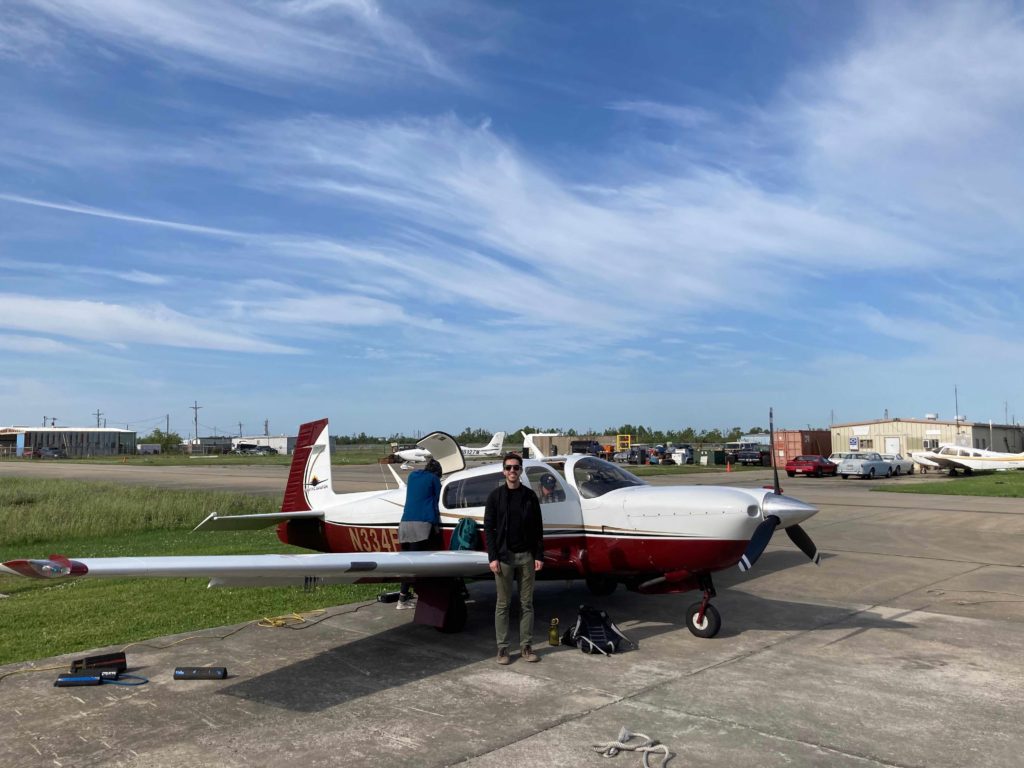
Yulia Chen, Stanford PhD student working on the F3UEL project, publishes a nice study on methane emissions in the Permian basin, which received some news attention.
We are interviewed and our work is referenced in this investigative reporting piece on flaring. More work coming out soon on flares from the F3UEL project.
Dr. Plant leads an innovative paper that outlines a new approach to quantifying urban methane emissions from space-based observations. We apply this approach to study a larger set of cities in the US and the world than ever before, showing persistent underestimates and that the US underestimates seem to be consistently explained by excess natural gas-sourced emissions. Figure 12 summarizes nicely, where the left gray bar shows our TROPOMI-based emission estimate, and the pink bar on the right shows EPA emissions if natural gas emissions are increased by 8x, which brings inventory observations in line with observations at cities with large or small natural gas infrastructure.
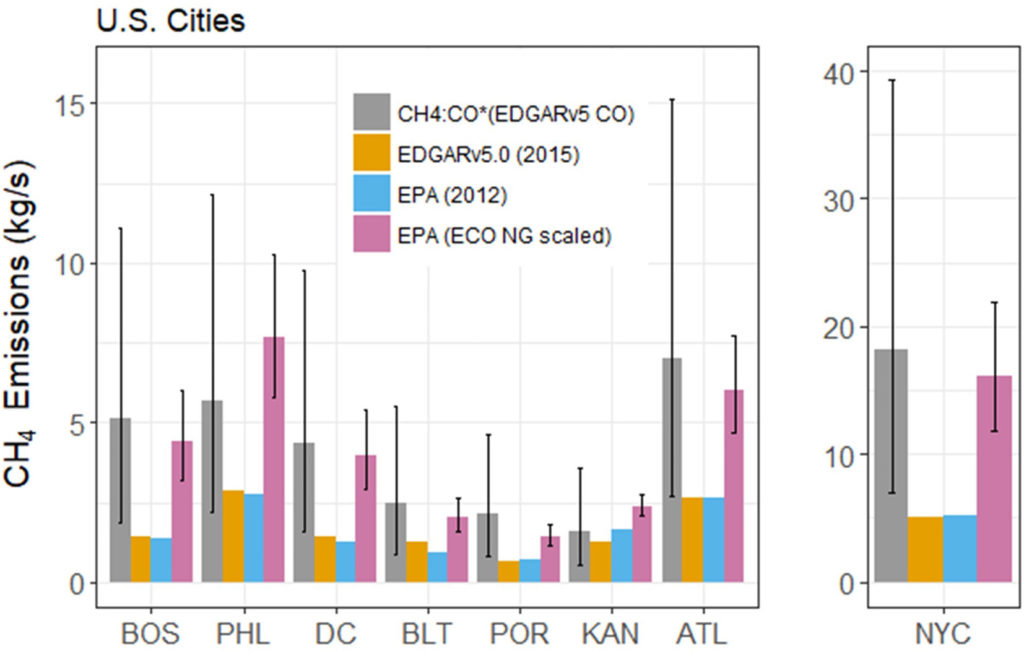
2021
The culmination of many years of work from the ORCAS team is this landmark study in Science on carbon exchange in the Southern Ocean.
Colleague Dr. Gerlein-Safdi led a study in GBC pioneering the use of CYGNSS data in estimated tropical wetland inundation for improving our representation of tropical wetland emissions.
Our work is invoked in a broader discussion of methane on VOX.
The culmination of a major workshop effort out of the Keck Institute for Space Studies at Caltech leads to this PNAS paper addressing Covid impacts on climate and air quality.
Our work is cited and we are interviewed in a discussion of urban methane emissions in the Washington Post. Earlier work led by Dr. Genny Plant is the major work that showed urban methane emissions were underestimated across a number of cities and serves as the foundation for the broader claims of urban methane emissions in the referenced PNAS article.
We are excited to welcome Dr. Mengze Li to our research team!
US Senate reverses Trump rollback of methane rules. Sen. Martin Heinrich once again invokes our methane work on the floor of the US Senate in making the case for methane rules.
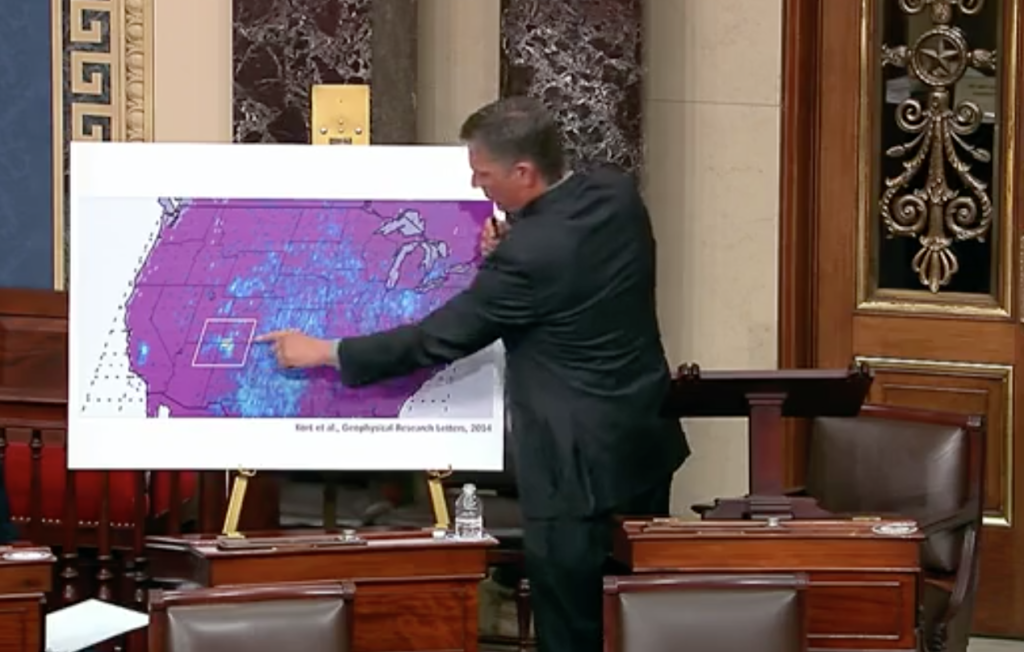
We are excited to see Carbon Mapper move forward, and play our small role.
National Academy report on Airborne Platforms to Advance NASA Earth System Science Priorities is published, outlining future science needs for a large research aircraft.
Successful meeting with the F3UEL science team and advisory committee. The next flights are scheduled for the Summer of 2021.
We (along w/ Dr’s Bloom & Gerlein-Safdi) were selected to become members of the CYGNSS science team, where we are excited to leverage the CYGNSS constellation to advance our understanding of tropical wetland emissions.
We (along w/ Dr’s Lin, Oda, Wennberg & Wu) were selected to continue to be members of the OCO-2/3 science team, where we will continue to advance the ability to quantify and attribute anthropogenic CO2 emissions from space.
2020
New Paper led by Daniel Huber observing soil NOx pulses using TROPOMI and SMAP.
Successful completion of AVIRIS-NG flights in California to study Covid-19 pandemic response impacts on California methane emissions.
Successfully completed year 1 flights for the F3UEL project!
Successful completion of flight sampling changes in ozone production conditions during the Covid-19 pandemic response in Denver and Houston.
Welcome to Raj Lal, new postdoc in the group.
New Paper led by Sandro Gvakharia using airborne measurement to show: 1) The ability to quantify ‘field-scale’ N2O fluxes with aircraft observations and 2) That fertilizer plant methane emissions are significantly underestimated.
Working with our friends at NOAA (and many others) to observe impacts of the Covid-19 response on urban emissions.
Nice coverage, including nice visuals and Reuters article, of Alan’s paper on offshore emissions.
The new project website is live for F3UEL (Flaring & Fossil Fuels: Uncovering Emissions & Losses) Project, supported by the Alfred P. Sloan Foundation.
The Permian Methane Analysis Project website, with lots of interactive information, is now live.
Alan’s paper on offshore emissions in the U.S. Gulf oF Mexico is published in ES&T! This study marks a major step forward in moving beyond studies of onshore oil and gas methane emissions to use observations to evaluate offshore emissions, where roughly 1/3 of global oil and gas are produced.
Data from our preliminary offshore study can be found on UM Deep Blue Archive.
Emily’s paper assessing urban emissions of carbon dioxide in the Middle East with OCO-2 observations is published. This work demonstrates the ability to assess different emissions inventories without sensitivity to prior spatial distributions and finds systematic underestimates for 5 cities midday emissions.
Nice coverage of Dien’s paper highlighting this big advance.
Congratulations to Dr. Sandro Gvakharia, who is starting as a Senior Researcher at Systems & Technology Research!
New paper led by Dien Wu presents the first time observations have been used to empirically assess the relationship between carbon dioxide emissions and urban density. Exciting application made possible by OCO-2 satellite!
2019
New paper led by postdoc Yaoxian Huang on seasonal urban methane emissions in the Baltimore/DC region published in ES&T.
Group photo from potluck dinner.
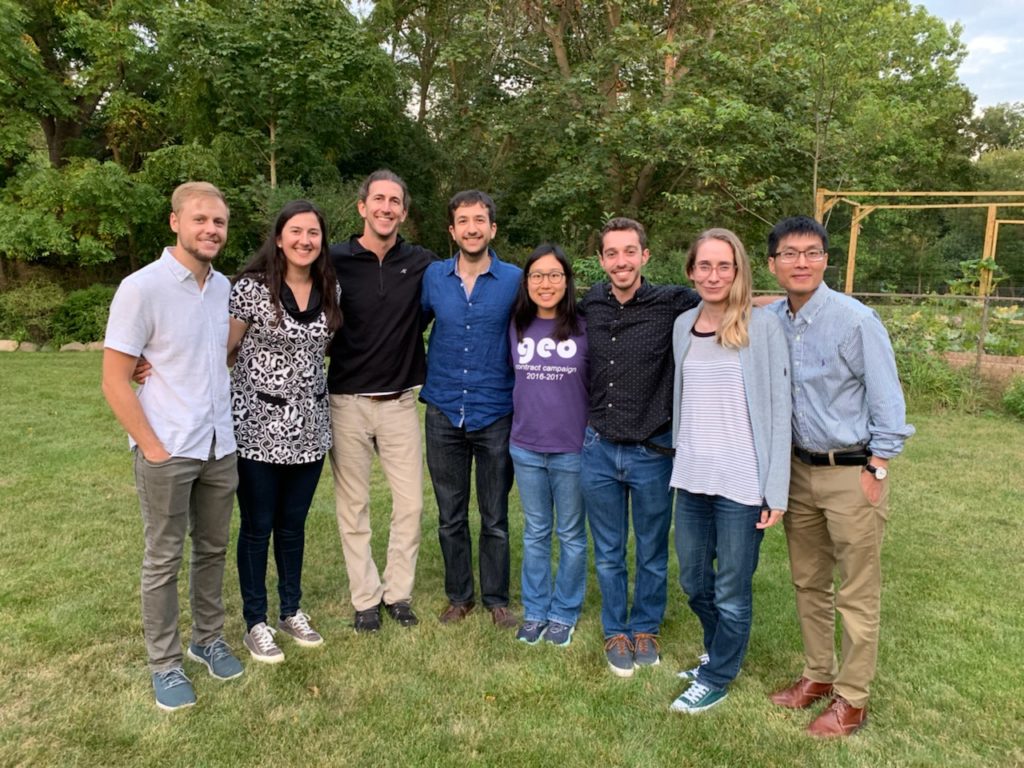
A new paper led by postdoc Genny Plant on urban methane emissions from major cities along the US East Coast is published in GRL. This work has been highlighted by Science, Nature, and other news outlets.
The WIRED article discusses the recent challenge of interpreting atmospheric methane variability with Prof. Kort. Prof. Kort also discusses this question with Colorado NPR.
Congratulations to Dr. Yaoxian Huang, who will be starting as an Assistant Professor this coming Fall at Wayne State University!
OCO-3 has successfully launched and is now berthed on the ISS — we are excited to use this new instrument.
Sandro Gvakharia successfully defends his thesis — congratulations Dr. Gvakharia!
Graduate student Alan Gorchov Negron is interviewed as part of the AGU narratives project — audio can be found here.
A new paper led by John on urban inversions is published in JGR. This work demonstrates the ability of urban inversions using operational meteorology to detect seasonal emission changes, anomalous events, and, after calibration with a trusted model, provide consistent absolute flux estimates.
PNAS Perspective piece on the recent behavior of atmospheric methane is published.
2018
Prof. Kort speaks with WEMU about natural gas pipelines.
New instrument paper from Sandro Gvakharia has now been published in AMT.
Data from the FEAST campaign is now available on Deep Blue.
European Commission Joint Research Council Report on Atmospheric monitoring and inverse modelling for verification of greenhouse gas inventories is published.
Synthesis paper led by EDF on US methane emissions from oil and gas is published in Science. Some discussion and coverage of the study can be found here and here.
Congratulations to Emily Yang for winning an NCAR essay contest and getting the opportunity to travel to Washington DC to meet with policymakers.
Congratulations to Emily Yang and Alan Gorchov Negron for passing the step 2 and step 1 qualifying exams (respectively).
John Ware successfully defends his thesis — congratulations Dr. Ware!
The first draft edition of a guidebook with Prof. Kort as a contributing author, on using space-based greenhouse gas measurements to inform emissions inventories, is published by the Japanese Institute for Environmental Studies.
Successful campaign sampling greenhouse gases along the East Coast — including the opportunity to fly along the Hudson River.

Interesting discussion in the Huffington Post including our work on methane from the Four Corners region.
Scientific American article discusses detecting methane from space with Prof. Kort
A quick start to 2018 with two field campaigns — one focused on offshore oil and gas emissions, as well as the second deployment of the Greenhouse gas Emissions in the Midwest (GEM-2) campaign.
2017
A busy AGU fall meeting with talks by Prof. Kort and Sandro Gvakharia, posters by Emily Yang and Dr. Gourdji, and talk/posters by collaborators Xinxin Ye, Dien Wu, and Matt Wozniak.
Another successful OCO-2 science team meeting with Prof. Kort updated the team on urban progress.
Fun and productive Megacities Carbon Project meeting in Pasadena where John Ware presents on some of our megacities work.
Kort group participates if the Greenhouse gas Emissions in the Midwest (GEM-1) campaign collecting flight measurements based in Minnesota.
Scientific American article on Arctic Methane references Kort’s group work on methane in the region.
The Center for Investigative Reporting article on Four Corners references the TOPDOWN study and findings.
Prof. Kort co-leads a workshop on methane at Caltech. Thanks to the Linde Center, KISS, and all participants for such a productive meeting!
Our work studying methane emissions from the Four Corners region played a prominent role in Senator Heinrich’s speech on the Senate floor — the figure he is showing is straight from Kort et al., GRL 2014. This work was also referenced by Senator Udall’s release.
Successful conclusions to FEAST (Fertilizer Emissions Airborne STudy) project! Excellent work by Sandro, Mackenzie, and Scientific Aviation as we demonstrated new measurement capabilities and have exciting data on nitrous oxide emissions from fertilizer plants and agricultural fields in the Mississippi River valley! It was particularly interesting this year given the historic flooding.
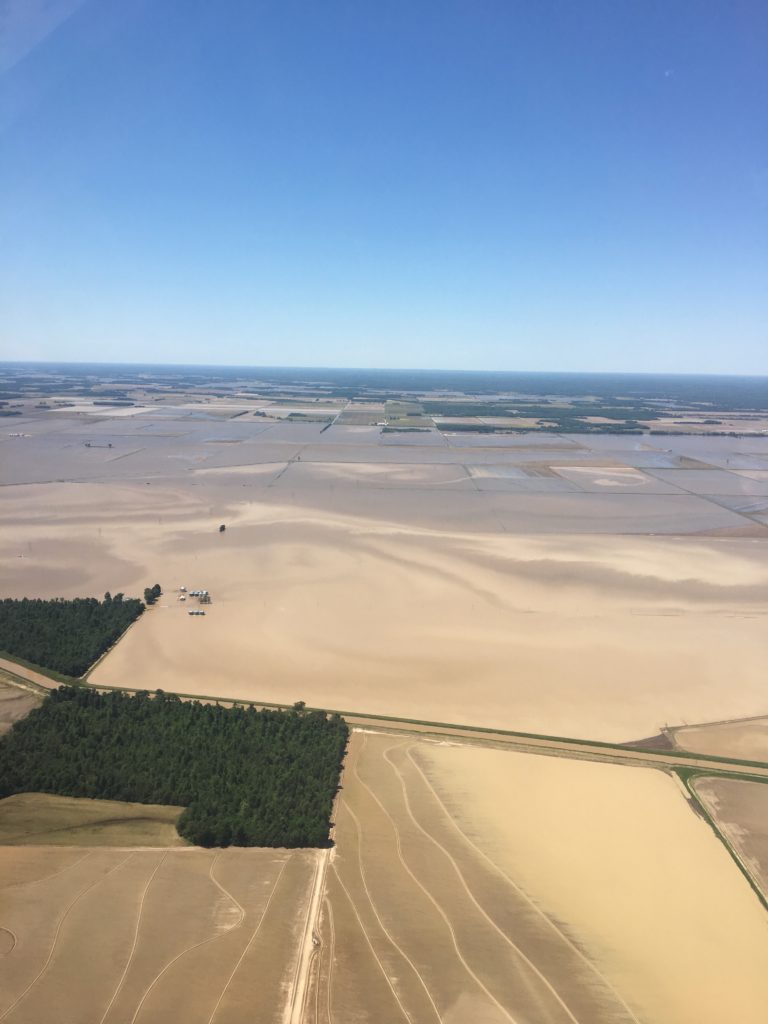
Climate Central’s article on pollutant emissions from Canada’s oil sands includes a discussion with Prof. Kort.
A paper led by postdoc Dr. Mackenzie Smith on quantifying methane emissions with aircraft in Four Corners is published in ES&T.
A paper led by graduate student Sandro Gvakharia on emissions of Methane, Ethane, and Black Carbon from incomplete flare combustion is published in ES&T.
Congratulations to graduate student Emily Yang for being selected to receive the National Science Foundation Graduate Research Fellowship!
Congratulations to Dr. Martin Hoecker-Martinez, who will be starting as an Assistant Professor at the University of Redlands this coming Fall!
Congratulations to Dr. Mackenzie Smith, who will be joining Scientific Aviation this Spring!
Prof. Kort’s NSF CAREER proposal “CAREER: Improving our understanding of nitrogen’s atmospheric impact on climate and ozone destruction” has been selected.
Our methane studies in Four Corners receive renewed attention as the work/figure appears in a number of articles and discussions on evolving EPA mandates. Wall Street Journal, KOB 4, NM, Albuquerque Journal, KRQE news 13, Sante Fe New Mexican.
Phys.org news article mentions our work in discussing contemporary methane emissions.
2016
Science news article on conflicting reasoning behind the recent rise in global methane includes a discussion with Prof. Kort.
The first paper from our Four Corners study is published in PNAS. This work demonstrates the use of airborne remote sensing to identify methane plumes at meter-level resolution in a complex environment. We also directly observe that emissions of methane from point sources in Four Corners exhibit a lognormal distribution, where the largest emitters contribute disproportionately to total basin emissions.
A paper led by graduate student John Ware was published in JGR-Atmosphere. Aerosol Lidar Observations of Atmospheric Mixing in Los Angeles: Climatology and Implications for Greenhouse Gas Observations.
Carbon dioxide measurements made by us and others on the ORCAS team show a 400 ppm threshold making its way into the far reaches of the Southern Hemisphere, exceeding levels last seen millions of years ago when sea level and temperatures were higher than today.
A paper on ethane emissions from the Bakken shale was just published in GRL, and received media attention, including by the Washington Post, the New York Times, ABC news, and Michigan Radio.
We are excited that Research Assistant Emily Yang will be joining the PhD program this fall.
NASA Earth Observatory article on methane discusses our work in Four Corners and the TOPDOWN flights we led as part of that effort.
Successful conclusions to ORCAS! Excellent work by the whole team to manage flights in such a remote region of the world, and handle wind evacuations with such grace. We are excited to look at the data in more detail (and sort photos from the field).
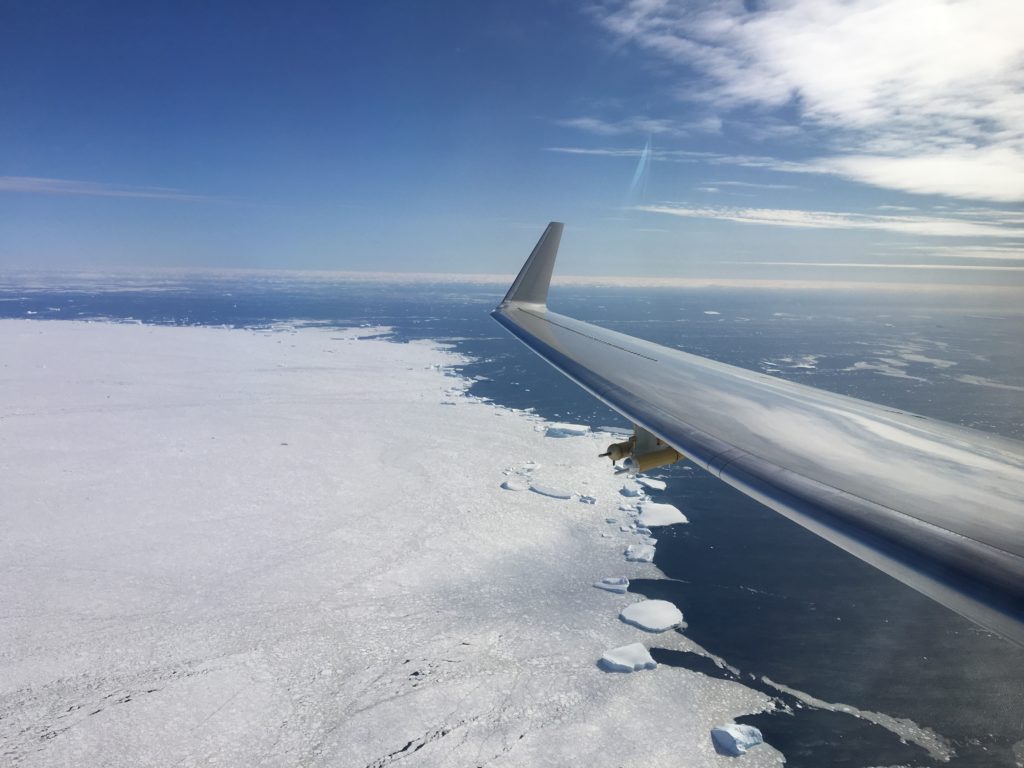
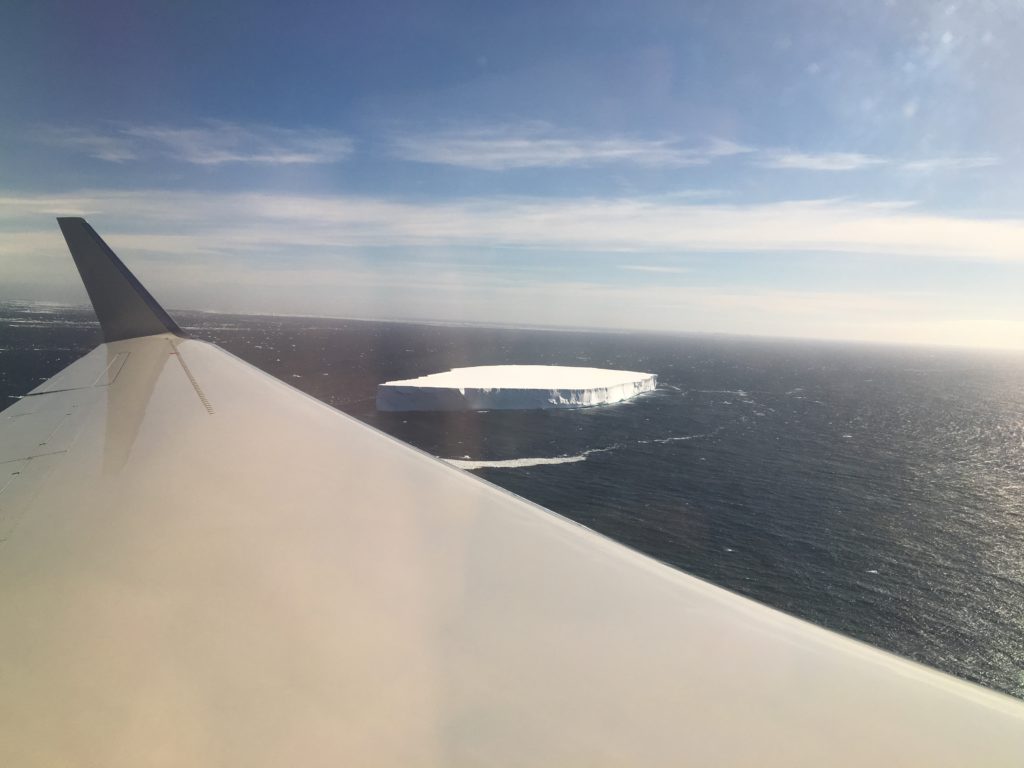
ORCAS project is off to a successful start! The campaign can be followed on the field catalog, and news articles are noted here as well.
2015
A paper on methane emissions from the Barnett shale bridging the gap between inventories and atmospheric studies is published in PNAS.
The 2nd post-launch OCO-2 Science Team Meeting was fun and productive- it is a very rich dataset!
We just completed a successful data workshop in Boulder that brought together multiple studies focused on emissions from oil and gas production. We are looking forward to seeing the finalized results that come out of these studies!
Welcome to Dr. Martin Hoecker-Martinez & Emily Yang, who have joined the group.
Prof. Kort gives an invited talk at the Atmospheric Chemistry Gordon Research Conference.
New Mexico Lawmakers reference our study in a letter to OMB Director Shaun Donovan.
Papers from the Barnett campaign are now out in ES&T, including an article led by postdoc Mackenzie Smith pioneering the use of continuous airborne ethane observations for methane source attribution and ethane flux quantification. The article
The team just completed a successful field campaign in the Four Corners region as part of TOPDOWN 2015. 5 aircraft, 2 mobile labs, and 1 satellite!

Postdoc Mackenzie Smith is profiled in an article about the Four Corners study.
Prof. Kort participates in a public forum in Farmington, NM discussing recent findings and the current study. Some media coverage on the forum and the current study being led by Kort and colleagues: KUNM, NPR, KOB, NBC, High Country News, KSL, Al Jazeera America, Weather Channel, Southern Ute Drum, Durango Herald, Tech Times, Headline & Global News, Digital Journal, Live Science, Discovery News, CTV news, Durango Herald, PBS Newshour.
Welcome to Dr. Kimberly Mueller, who will be joining the group as a visiting research scientist from NIST.
The ORCAS campaign was selected- we will be studying the exchange of CO2 and O2 over the Southern Ocean in January-February 2016.
Prof. Kort discusses methane in an invited talk at the ACS meeting in Denver Reporting Climate Science, Phys.org.
Secretary of the Interior Sally Jewell refers to our work on methane in the Southwestern US in her remarks given at the Center for Strategic and International Studies.
We were selected to be members of the OCO-2 science team, with a focus on studying urban carbon emissions.
2014
Josh Gray (collaborator at BU) leads a Nature paper highlighting the role agricultural systems play on seasonal cycles of CO2. The article, Nature news, and views, NSF, Science Blog, Tech times.
We have posted a FAQ for our recently published study on methane in the Four Corners area to answer questions and clarify confusion from some media reports. FAQ
Media attention for the Four Corners work: USA Today, Discovery, NPR, KQED, Slate, NBC News, Christian Science Monitor, Bloomberg, Time, The Hill, Scientific American, Washington Post, National Geographic, Climate Central, Huffington Post, NPR PRI.
Our paper on methane in the Four Corners region has come out in GRL, and was featured as an editor’s choice.
Our NOVIM synthesis study led by Prof. Adam Brandt was published in Science. A sampling of media attention on this work: New York Times, LA Times, Stanford News, Michigan Daily.
2013
Scot Miller led a study on anthropogenic emissions of methane published in PNAS. Prof. Kort discussed the study on NPR’s here & now: link.
